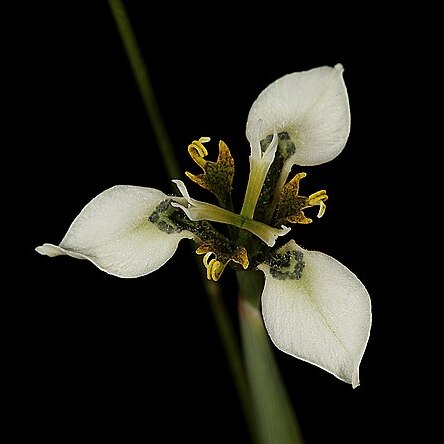Perennial herb, geophyte, 0.2-0.4 m high; corm tunics of brown netted fibres; stem simple or few-branched. Leaf 1, linear, canaliculate, usually trailing above. Spathes herbaceous, partly dry, attenuate. Inflorescence with white to cream-coloured, brownish, rarely violet flowers; nectar guides white to cream-coloured or yellow; tepals unequal, inner 12-22 mm long, lanceolate, reflexed, villous, inner 7-12 mm long, erect, tricuspidate. Stamens: filaments 4-6 mm long, free only near apex; anthers 3-4 mm long, apiculate, appressed to style branches; pollen usually yellow. Ovary 6-8 mm long, nearly cylindric; style branches ± 5 mm long; crests erect, 2.5-4.0 mm long. Flowering time Sept.-Jan. Capsule obovoid.
Cormous geophyte, 200-400 mm tall. Leaf 1, narrow, channelled. Flowers enclosed in green spathes, white to cream (brownish or violet elsewhere), outer tepal limbs spreading, inner tepals 3-lobed with inrolled or straight central cusp, filaments united below, style branches narrow, crests short.
Cormous geophyte, 20-50 cm. Leaf solitary. Flowers white to cream-coloured or brownish, rarely violet, inner tepals tricuspidate with inrolled or straight, central cusp.
A herb. It is a bulb plant. It grows 20-40 cm tall. There is one narrow channelled leaf. The flowers are enclosed in green spathes. The flowers are white to cream.

